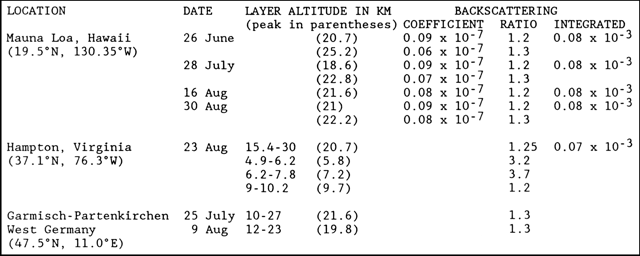Report on Atmospheric Effects (1980-1989) — August 1988

Atmospheric Effects (1980-1989)
Scientific Event Alert Network Bulletin, vol. 13, no. 8 (August 1988)
Managing Editor: Lindsay McClelland.
Atmospheric Effects (1980-1989) Tropospheric layers probably from forest fires
Please cite this report as:
Global Volcanism Program, 1988. Report on Atmospheric Effects (1980-1989) (McClelland, L., ed.). Scientific Event Alert Network Bulletin, 13:8. Smithsonian Institution.
Atmospheric Effects (1980-1989)
All times are local (unless otherwise noted)
Lidar data indicated that few aerosols remain in the stratosphere from the November 1985 Ruiz eruption, and no subsequent eruptions appear to have produced large amounts of stratospheric ejecta. At Mauna Loa, Hawaii, the small lower stratospheric layers observed in early and mid June were not detected on 26 June or in subsequent measurements (figure 61). Stratospheric aerosols measured at Hampton, VA continued their gradual decline. However, relatively dense layers, perhaps from major forest fires in the western United States, were evident in the troposphere during observations on 23 August. Winds at about 5.8 km altitude on 22 and 23 August were favorable for transport of smoke from the fires to the Hampton area. Late July-early August data from Garmisch-Partenkirchen, West Germany were similar to those of early July.
Information Contacts: William Fuller, NASA Langley Research Center, Hampton, VA 23665 USA; Thomas DeFoor, Mauna Loa Observatory, P. O. Box 275, Hilo, HI 96720 USA; Horst Jäger, Fraunhofer-Institut für Atmosphärische Umweltforschung, Kreuzeckbahnstrasse 19, D-8100 Garmisch-Partenkirchen, West Germany.

